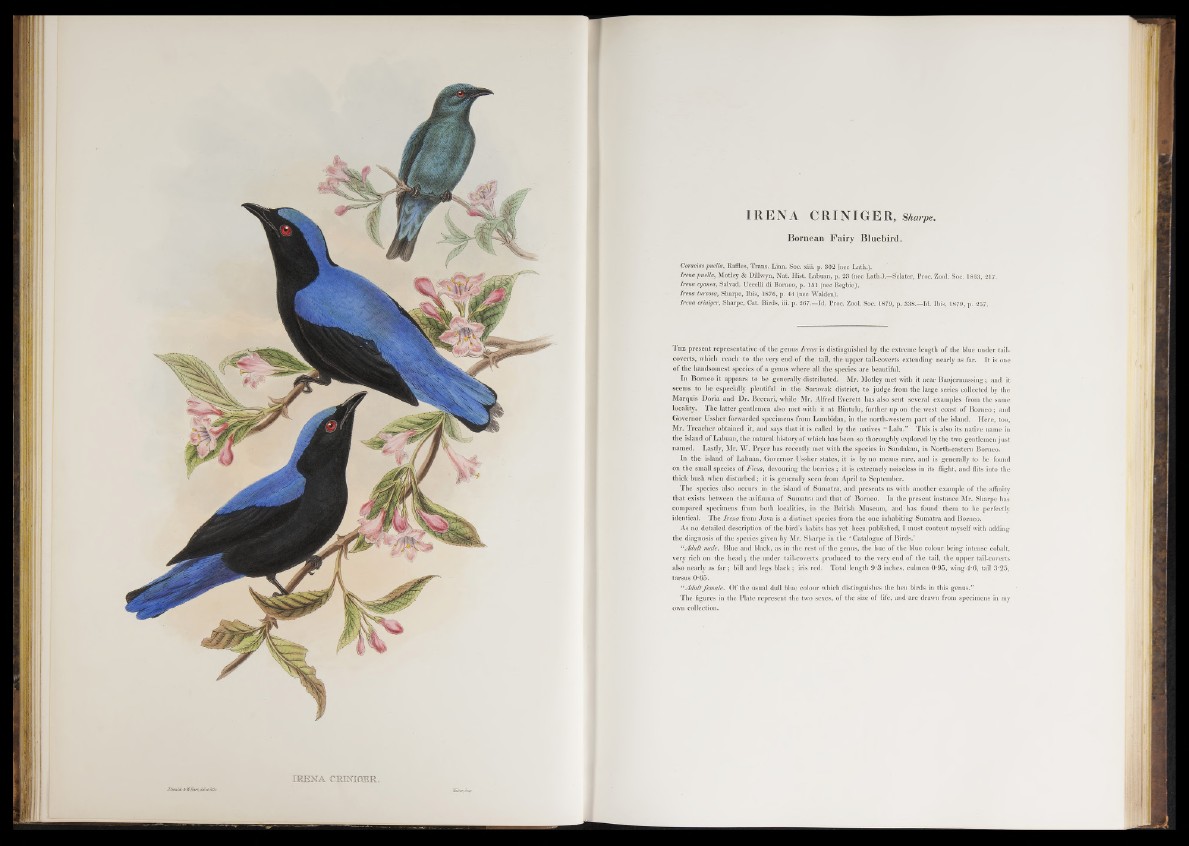
IRENA CRINIGER, Sharpe.
Bornean Fairy Bluebird.
Coracias puella, Raffles, Trans. Linn. Soc. xiii. p. 302 (nec Lath.), y '
Irena puella, Motley & Dillwyn, Nat. Hist. Labuan, p. 23 (nec Lath.).—Sclater, Proc. Zool. Soc. 1863, 217.
Irena cyanea, Salvad. Uccelli di Borneo, p. 151 (nec Begbie).
Irena turcosa, Sharpe, Ibis, 1876, p. 44 (nec Walden).
Irena criniger, Sharpe, Cat. Birds, in. p. 2 6 7— Id. Proc. Zool. Soc. 1879, p. 338.—Id. Ibis, 1879, p. 257.
T h e present representative of the genus Irena is distinguished by the extreme length of the blue under tail-
coverts, which reach to the very end of the tail, the upper tail-coverts extending nearly as far. It is one
o f the handsomest species of a genus where all the species are beautiful.
In Borneo it appears to be generally distributed. Mr. Motley met with it near Banjermassing; and it
seems to be especially plentiful in the Sarawak district, to j udge from the large series collected by the
Marquis Doria and Dr. Beccari, while Mr. Alfred Everett has also sent several examples from the same
locality. The latter gentlemen also met with it at Bintulu, further up on the west coast o f Borneo; and
Governor Ussher forwarded specimens from Lumbidan, in the north-western part of the island. Here, too,
Mr. Treacher obtained it, and says that it is called by the natives “ Lalu.” This is also its native name in
the island of Labuan, the natural history of which has been so thoroughly explored by the two gentlemen just
named. Lastly, Mr. W. Pryer has recently met with the species in Sandakan, in North-eastern Borneo.
In the island o f Labuan, Governor Ussher states, it is by no means rare, and is generally to be found
on the small species of Ficus, devouring the berries ; it is extremely noiseless in its flight, and flits into the
thick bush when disturbed; it is generally seen from April to September.
The species also occurs in the island of Sumatra, and presents us with another example of the affinity
that exists between the avifauna of Sumatra and that of Borneo. In the present instance Mr. Sharpe has
compared specimens from both localities, in the British Museum, and has found them to be perfectly
identical. The Irena from Java is a distinct species from the one inhabiting Sumatra and Borneo.
As no detailed description of the bird’s habits has yet been published, I must content myself with adding
the diagnosis of the species given by Mr. Sharpe in the ‘ Catalogue of B irds.’
“Adult male. Blue and black, as in the rest of the genus, the hue of the blue colour being intense cobalt,
very rich on the h e ad ; the under tail-coverts produced to the very end of the tail, the upper tail-coverts
also nearly as f a r ; bill and legs black; iris red. Total length 9*3 inches, culmen 0 ’95, wing4‘6, tail 3 -25,
tarsus 0 ‘65.
“ Adult female. Of the usual dull blue colour which distinguishes the hen birds in this genus.”
The figures in the Plate represent the two sexes, of the size of life, and are drawn from specimens in my
own collection.